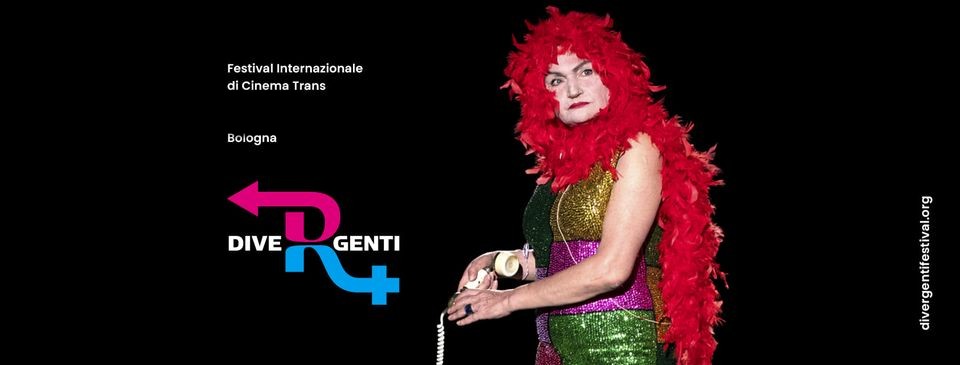Transgender Persons & Media 6th Film Festival on Transgender themes, Bologna, Italy May 2013
By Sunil Deepak, July 2013
As part of "Divergenti - International Film Festival on Trans-sexual issues" held in Bologna (Italy) in May 2013, a workshop was organized on how media reports about trans-sexual issues and to provide some guidance about how issues related to trans-sexual people can be communicated.
The workshop had two main speakers from the UK based Trans Media Watch - www.transmediawatch.org - Helen Belcher (director of TMW) and Jane Fae, a British journalist (In the image below).
Trans-sexual people every where are usually surrounded by misconceptions. In India, where I grew up, there is little real knowledge about trans-sexual persons known as Hijra or Khusra or Kinnar, though they have a well defined derogatory social role - to come and ask for alms during auspicious occasions (marriages, child birth, festivals). According to the popular perception, they also work as sex-workers. In the every day reality, they are ostracised and discriminated in a vicious manner, at all levels.
Gender is about being a man or woman, and behaving as a man or a woman. It is about male and female identities of persons.
Three levels of Gender Identification
Helen Belcher talked about three levels of gender identification - at the level of genitals, at the level of chromosomes and at the level of persons' brains. For each of these levels, completely male and completely female can be seen as two extremes and there is a range (spectrum) of positions in between those two extremes. Usually, the gender at all the three levels is same, but in many persons these three levels can be independent of each other, as shown in the image below:
External genitals can be completely male or female or they can have some mixed characters (inter-sexual).
In terms of chromosomes, males have XY sex chromosomes, female have XX chromosomes, while some persons can have different configuration such as XXY.
At the brain level or emotional level, persons can feel male or female, even if their genitals or chromosomes may not match these feelings. Most persons can recognise a male and female parts in themselves.
Thus a person can have outwardly completely male genitals and yet at chromosome level may not have the XY chromos or at the level of feelings, may feel to be a female. Similarly a person may have female genitals and yet feel to be a male.
Trans-sexual persons have always existed in the history, though only in the past few decades, they have been able to come out in public and ask for their human rights.
Historically, the issue of trans-sexuality was treated as a mental health issue and has been medicalized, called as "gender identity disorder". There have been debates if it has a biological origin.
To be a transgender person is not a choice
It is important to understand that being a trans-person is not a choice, people do not choose to be trans-sexual. Given the exclusion and discrimination that trans-persons have to go through, if it was just a question of choice, why do people go through it? They go through it because it something too deep in them, it is not a question of choice.
All of us go through a continuous and unrelenting conditioning from early childhood that construct our identities in terms of boyness and girlness. To question that conditioning is difficult and transition (the process of changing gender) is a process that does not ever end. Some people believe that just because you have had a surgical operation, you have changed gender and your transition is complete, that is not true. Transition is a process, where you challenge that childhood conditioning every day.
Stereotypes about transgender persons
There are many stereotypes about trans-persons. For example, that they all do comedy shows or that they are acting, they are "putting on a show", they are not who they say they are. They are seen as exotic and extravagant, non caring persons. Or that they are sex workers. They are not seen as ordinary persons.
The word trans-gender is an umbrella term. There are many other related terms such as cross-dresser, gender variant, trans-sexual, poly-gender, drag queen or drag king, transvestite, etc. Some of these words have different definitions, their boundaries are fluid and keep on changing. These identities are dynamic, their precise meanings can keep on changing at different points in the lives of persons.
Gender identity and sexual orientation
Often people confuse between the transgender issues and issues related to sexual orientation. Helen Belcher explained it very clearly when she said, "Gender is about who you feel to be, a man or a woman. Sexual orientation is about with whom do you wish to have sex."
There are transgender women (persons who were given male gender identity at birth), who wish to have sex with men while there are others who prefer other women or transgender women. There are transgender men (persons who were given female identity at birth) who like sex with other men or with women or with transgender women. Equating transgender issues with being gay or lesbian is not correct, though all these groups often face similar social barriers in terms of prejudice, discrimination, violence, abuse, etc.
In conclusion
These are just some of the idea presented by Helen in the workshop. Persons working the media, like everyone else in the public, also have the same mis-conceptions and stereotypes about trans-gender persons and by writing about these issues in a particular way, amplify those ideas and make them more universal. Thus, it is important that media-persons can have a dialogue with and understand the different issues linked to trans-gender persons.
***
Back to the Home-Page - Index of LGBTQ-Related Films
